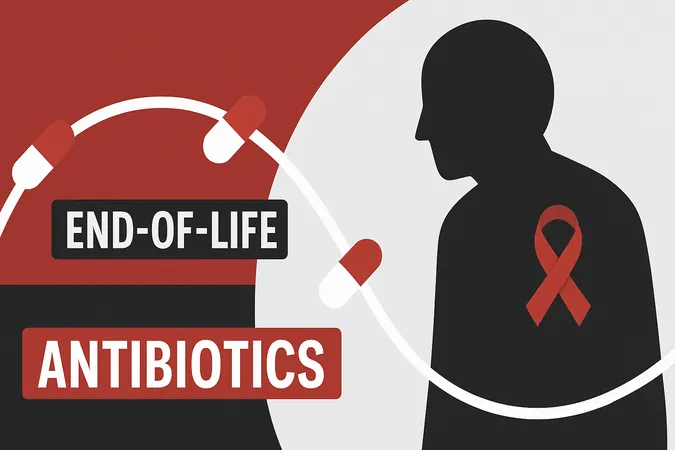
Timing is Everything: The Alarming Trends in Antibiotic Use for Advanced Cancer Patients Near Death
2025-09-16
Author: Sarah
Revealing Antibiotic Use Patterns in End-of-Life Care
A recent study has unveiled striking patterns of broad-spectrum antibiotic use among patients with advanced cancer as they approach the end of life. Surprisingly, this use doesn’t just happen haphazardly; it clusters in specific time periods—particularly peaking between three and one month prior to death. Among a massive cohort of over 515,000 South Koreans, 55.9% were prescribed at least one broad-spectrum antibiotic in their final six months.
Peaks of Prescriptions: The Critical Moments Before Death
The data shows that a significant 28.1% of patients received antibiotics in the critical window of three months to one month before death. This rate plummeted to just 13.3% in the final week, indicating that during their last days, fewer patients are treated, but those who are are often extremely unwell. The study found that the days of therapy per 1,000 patient-days reached a staggering peak of 190.0 between one month and two weeks before death.
What Drives These Choices?
The study investigator, Dr. Shin Hye Yoo, sheds light on this troubling trend. He suggests that the spike in antibiotic use correlates with the deterioration of physical function typical of advanced cancer patients. As they begin to exhibit symptoms like fever, doctors often resort to broad-spectrum antibiotics, even when the exact cause of infection remains uncertain. This highlights the crucial need for conversations between healthcare providers, patients, and families about the potential benefits and burdens of such treatments in the final months.
Hematologic Malignancies: A More Complicated Picture
The study indicates that patients with blood cancers (hematologic malignancies) received antibiotics more frequently than those with solid tumors. This difference poses unique challenges for caregiving. Due to their compromised immune systems, patients with blood cancers often face severe vulnerability to infections, making end-of-life planning and home care transitions significantly more complex. Continuous antibiotic use in these cases can complicate the patient's values and care preferences.
Aligning Antibiotic Use with Patient Goals
Dr. Yoo advocates for more intentional antibiotic prescribing during these late stages of life. The key takeaway is that while we can identify periods of heightened antibiotic use, recognizing when a patient is truly transitioning into their final phase can be difficult. The approach suggested is the implementation of time-limited antibiotic trials, allowing treatment continuity only if patients genuinely benefit. This model not only mitigates unnecessary treatments but also respects patient wishes and goals.
Conclusion: Critical Insights for Patient-Centric Care
This comprehensive study underscores a pivotal opportunity for healthcare professionals to rethink antibiotic prescribing in advanced cancer patients nearing death. By focusing on those critical time markers, especially for hematologic malignancies, we can harmonize treatment with what truly matters to patients—comfort, dignity, and alignment with their personal goals.
Key Takeaways
1. Broad-spectrum antibiotics are most frequently prescribed in the months leading up to death, revealing a need for careful stewardship. 2. More than half of patients receive antibiotics in their last six months, particularly those with blood cancers. 3. Adopting time-limited antibiotic trials can enhance alignment with patient goals, reducing unnecessary treatments.
 Brasil (PT)
Brasil (PT)
 Canada (EN)
Canada (EN)
 Chile (ES)
Chile (ES)
 Česko (CS)
Česko (CS)
 대한민국 (KO)
대한민국 (KO)
 España (ES)
España (ES)
 France (FR)
France (FR)
 Hong Kong (EN)
Hong Kong (EN)
 Italia (IT)
Italia (IT)
 日本 (JA)
日本 (JA)
 Magyarország (HU)
Magyarország (HU)
 Norge (NO)
Norge (NO)
 Polska (PL)
Polska (PL)
 Schweiz (DE)
Schweiz (DE)
 Singapore (EN)
Singapore (EN)
 Sverige (SV)
Sverige (SV)
 Suomi (FI)
Suomi (FI)
 Türkiye (TR)
Türkiye (TR)
 الإمارات العربية المتحدة (AR)
الإمارات العربية المتحدة (AR)